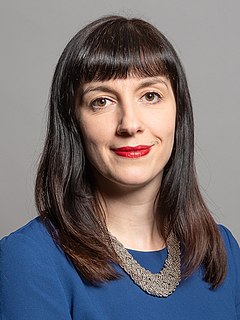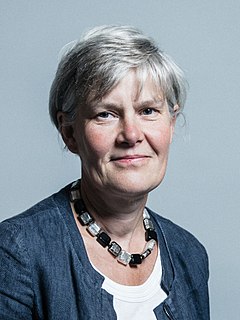Related Research Articles

Harriet Ruth Harman is a British politician and solicitor who has served as Member of Parliament (MP) for Camberwell and Peckham, formerly Peckham, since 1982. A member of the Labour Party, she has served in various Cabinet and Shadow Cabinet positions.

Dame Angela Eagle DBE is a British Labour Party politician serving as the Member of Parliament (MP) for Wallasey since 1992. Eagle was born in Yorkshire and studied PPE at the University of Oxford, before working for the CBI and then a trade union.

Maria Eagle is a British politician who served in the governments of Tony Blair and Gordon Brown. She later served in the Shadow Cabinets of Ed Miliband and Jeremy Corbyn. A member of the Labour Party, she has been Member of Parliament (MP) for Garston and Halewood, previously Liverpool Garston, since 1997.

Angela Evans Smith, Baroness Smith of Basildon, is a British politician and life peer serving as Leader of the Opposition in the House of Lords since 2015. A member of the Labour and Co-operative parties, she was Member of Parliament (MP) for Basildon from 1997 to 2010.

Sharon Hodgson is a British Labour Party politician serving as the Member of Parliament (MP) for Washington and Sunderland West, previously Gateshead East and Washington West, since 2005.

The Leader of the Labour Party is the head of the Labour Party of the United Kingdom. The current leader is Sir Keir Starmer, who was elected in April 2020 to succeed Jeremy Corbyn, having previously spent 9 months as Shadow Minister of Immigration and 3 years, 5 months as Shadow Secretary of State for Exiting the European Union in Corbyn's shadow cabinet.

Bridget Maeve Phillipson is a British politician serving as Shadow Secretary of State for Education since 2021. A member of the Labour Party, she has been Member of Parliament for Houghton and Sunderland South since 2010. She served as Shadow Chief Secretary to the Treasury from 2020 to 2021.

Katherine Anne Green OBE is a British politician serving as Member of Parliament (MP) for Stretford and Urmston since 2010. A member of the Labour Party, she was Shadow Minister for Women and Equalities from 2015 to 2016 and Shadow Secretary of State for Education from 2020 to 2021. Green served as Chair of the Committee on Privileges and Committee on Standards from 2018 to 2020.

Lilian Rachel Greenwood is a British Labour Party politician serving as the Member of Parliament (MP) for Nottingham South since 2010, and the Opposition Deputy Chief Whip of the House of Commons since 2021.
The Commons members of the Parliamentary Labour Party (PLP) elected 19 members of the Shadow Cabinet from among their number in 2010. This follows the Labour Party's defeat at the 2010 general election, after which the party formed the Official Opposition in the United Kingdom.
Elections to the Labour Party's Shadow Cabinet took place in July 1992. Shadow Cabinet elections generally take place at the beginning of a parliamentary session, but the 1992 vote was postponed until a new leader was elected to replace Neil Kinnock. Under the rules then in effect, the Commons members of the Parliamentary Labour Party elected 18 members of the Official Opposition Shadow Cabinet, who were then assigned portfolios by the leader. The Commons members of the PLP separately elected the Chief Whip, and the Labour peers elected the Leader of the Opposition in the House of Lords. In addition, the Leader of the Labour Party and Deputy Leader were members by virtue of those offices. The 18 elected members of the Shadow Cabinet were the ones with the largest number of votes, except that the three women with the most votes would be included in the 18, even if they were not among the top 18 based on the number of votes.
Elections to the Labour Party's Shadow Cabinet took place in October 1993, at the beginning of the 1993/1994 session of parliament. Under the rules then in effect, the Commons members of the Parliamentary Labour Party elected 18 members of the Official Opposition Shadow Cabinet, who were then assigned portfolios by the leader. The Commons members of the PLP separately elected the Chief Whip, and the Labour peers elected the Leader of the Opposition in the House of Lords. In addition, the Leader of the Labour Party and Deputy Leader were members by virtue of those offices. The 18 elected members of the Shadow Cabinet were the ones with the largest number of votes. Beginning with this election, MPs were required to vote for at least four women, but women were no longer guaranteed three places in the Shadow Cabinet.
Elections to the Labour Party's Shadow Cabinet took place in October 1994, at the beginning of the 1994/5 session of parliament. Under the rules then in effect, the Commons members of the Parliamentary Labour Party elected 18 members of the Official Opposition Shadow Cabinet, who were then assigned portfolios by the leader. The Commons members of the PLP separately elected the Chief Whip, and the Labour peers elected the Leader of the Opposition in the House of Lords. In addition, the Leader of the Labour Party and Deputy Leader were members by virtue of those offices. The 18 elected members of the Shadow Cabinet were the ones with the largest number of votes. MPs were required to vote for at least four women, but women were not necessarily guaranteed places in the Shadow Cabinet.
Elections to the Labour Party's Shadow Cabinet took place in October 1995, at the beginning of the 1995/6 session of parliament. Under the rules then in effect, the Commons members of the Parliamentary Labour Party elected 19 members of the Official Opposition Shadow Cabinet, who were then assigned portfolios by the leader. The Labour peers elected the Leader of the Opposition in the House of Lords. In addition, the Leader of the Labour Party and Deputy Leader were members by virtue of those offices. With this election, for the first time, the role Opposition Chief Whip was simply another portfolio to be handed out rather than an office separately elected by the PLP. The 19 elected members of the Shadow Cabinet were the ones with the largest number of votes. MPs were required to vote for at least four women, but women were not necessarily guaranteed places in the Shadow Cabinet.

Ed Miliband became Leader of the Labour Party and Leader of the Opposition upon being elected to the former post on 25 September 2010. The election was triggered by Gordon Brown's resignation following the party's fall from power at the 2010 general election, which yielded a Conservative – Liberal Democrat Coalition. Miliband appointed his first Shadow Cabinet in October 2010, following the Labour Party's Shadow Cabinet elections. These elections were the last such elections before they were abolished in 2011.
Elections to the Labour Party's Shadow Cabinet took place on 19 November 1981. There were 15 posts, rather than 12 as in previous years. In addition to the 15 members elected, the Leader, Deputy Leader, Labour Chief Whip, Labour Leader in the House of Lords, and Chairman of the Parliamentary Labour Party were automatically members.

Jeremy Corbyn assumed the position of Leader of the Opposition after being elected as leader of the Labour Party on 12 September 2015; the election was triggered by Ed Miliband's resignation following the Labour Party's electoral defeat at the 2015 general election when David Cameron formed a majority Conservative government. The usual number of junior shadow ministers were also appointed.
Elections to the Labour Party's Shadow Cabinet took place on 24 October 1990. Under the rules then in effect, the Commons members of the Parliamentary Labour Party elected 18 members of the Official Opposition Shadow Cabinet, who were then assigned portfolios by the leader. The Commons members of the PLP separately elected the Chief Whip, and the Labour peers elected the Leader of the Opposition in the House of Lords. In addition, the Leader of the Labour Party and Deputy Leader were members by virtue of those offices.
Elections to the Labour Party's Shadow Cabinet took place on 23 October 1991. Under the rules then in effect, the Commons members of the Parliamentary Labour Party elected 18 members of the Official Opposition Shadow Cabinet, who were then assigned portfolios by the leader. The Commons members of the PLP separately elected the Chief Whip, and the Labour peers elected the Leader of the Opposition in the House of Lords. In addition, the Leader of the Labour Party and Deputy Leader were members by virtue of those offices.
Elections to the Labour Party's Shadow Cabinet occurred in November 1989. For these elections the Shadow Cabinet was expanded from 15 to 18 seats and, for the first time, MPs had to cast at least three votes for women.
References
- "Shadow Cabinet Elections in the 1992 Parliament". Archived from the original on 14 July 2010. Retrieved 24 May 2010.